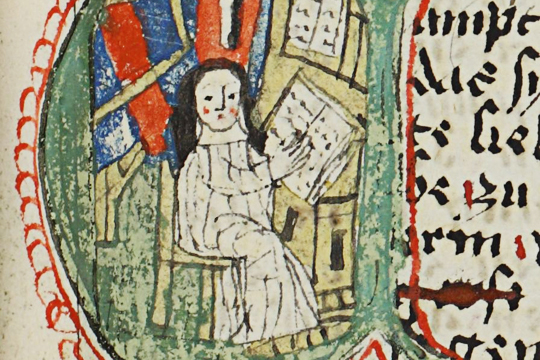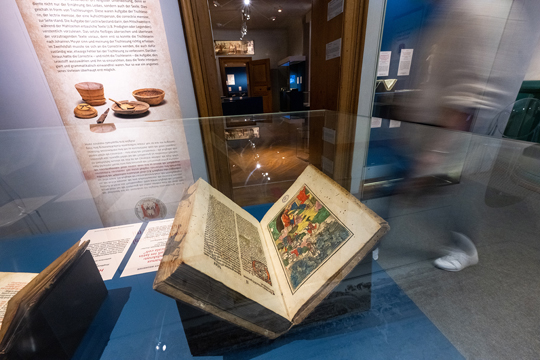“Lending speech and sound to books”
Freiburg, Apr 19, 2021
Anyone who wants to view the treasure trove of regional medieval books should take a look at the exhibition “buochmeisterinne – Manuscripts and Early Printed Books from the Dominican Convent in Adelhausen.” Students of German medieval studies laid the groundwork for the annotated collection in teaching projects on so-called research-based learning, which is on display until June 13 at the Freiburg Museum of Urban History in the Wentzingerhaus on Münsterplatz, a visit is possible subject to the currently valid pandemic regulations after prior registration. The exhibition comes from the city’s holdings and the Adelhausen Foundation as well as on loan from libraries in Karlsruhe, Zurich, Switzerland and Colmar, France.

In the medieval monasteries femal book librarian took care of the maintenance and cataloging of the stock. In this office book of Johannes Meyer one of these “buochmeisterinne“ is shown. Photo: Universitätsbibliothek Leipzig, MS 1548, fol. 89r
Student Gregor Biberacher’s encounter during a visit to the Freiburg City Archives as part of a manuscript seminar in medieval studies surpassed anything he had ever held in his hands before: 500 to 600-year-old folios, all of them unique, written in Middle High German. “I was overcome with a sense of awe and fascination.” Biberacher was a participant in a teaching project on research-based learning in medieval German studies led by Prof. Dr. Martina Backes and Dr. Balászs J. Nemes.
Nemes’ idea was that course-based findings should be accessible not only to researchers, but also to the public. Therefore, the results of the teaching project, in which the students investigated the medieval world of monastic librarians, were transformed into an exhibition. In addition, a catalog with contributions from the students is in preparation. The exhibition is a contribution to Freiburg’s city anniversary, financed with funds from the Adelhausen Foundation, which is the legal successor to the five Dominican nunneries that existed in Freiburg in the Middle Ages. The exhibition reveals the world of these Dominican nunneries. “We are trying to reconstruct the books’ 'setting in life’ by tracing the people behind the books,” explains Backes.
Community-building texts
To access the ancient writings, the exhibition activates all the senses. Singer Clara Coutouly sang two pieces, accessible via QR code, in the chapel of St. Ottilien, notated on huge hymnals written on parchment. Students who received speech training during the seminar read Middle High German texts on audio recordings, just as the monastery’s table reader read them during meals. “We wanted to lend speech and sound to the books,” Nemes explains. “The manuscripts were primarily geared toward public recitation, so they have a community-building quality about them,” Biberacher says. “The nuns did more than solitary studying in libraries.”

Course-based findings should be accessible also to the public. Therefore, the results of the teaching project about the “buochmeisterinne“ were transformed into an exhibition. Photo: Patrick Seeger
Medieval interlibrary loan
In the monasteries there was the “buochmeisterinne,”, a book librarian who took care of the maintenance and cataloging of the stock. New books were added that were bought or donated to the monastery. A book caretaker also had access to a type of interlibrary loan. A network of friendly monasteries in the region supplied each other with manuscripts that could be used as models for copying. For the first time in 500 years, for example, the original and copy of the sermons of Johann Geiler of Kaysersberg, an important German preacher in the late Middle Ages, have reunited in the exhibition.
The life of the nuns was organized through the monastic offices. Above all, the office of the novice mistress, who was responsible for the education of the young women, indicates that the convent was a “unique space of knowledge” for women, as Backes explains. After all, unlike their brothers in the order, they were not allowed to study theology at universities. However, the women did not always enter the convent out of a thirst for knowledge and their own spiritual drive. Many were sent by their families with a rich dowry. As two issued “Urbare” or so-called land registers show, the acquired assets were recorded in writing. “These books were used for administrative purposes,” explains Backes.
Student detective work
A sermon manuscript by Johannes Tauler from the 14th century, which had already been researched for 150 years, aroused the special “archaeological-criminological” interest of one student participating in the teaching project, says Nemes. The names of the two sisters who had owned the manuscript had to be deciphered. The student had searched in archives and found out that one of the sisters had lived in what is now Freiburg’s Deutschordensstraße. Excavations on the property, Nemes says, revealed the outline of the house at the time. Martina Backes is thrilled. “One of our books on display was read in this house centuries ago. If the student had been interested in the only in the text’s content, he never would have figured it out.” That’s what she and Nemes mean by research-based learning.
Anita Rüffer
buochmeisterinne – Manuscripts and Early Printed Books from the Dominican Convent in Adelhausen

